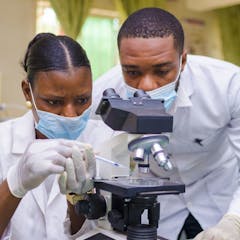
Articles on Science funding
Displaying 1 - 20 of 137 articles

The deal will bring relief to UK scientists after Brexit led to uncertainty over funding and collaborative projects.

The war in Ukraine has led to the destruction of scientific infrastructure, caused many Ukrainian researchers to leave the country and disrupted the work of those who have stayed.

Overall, women receive a smaller share of research funding – but it’s not due to how applications are weighed up. The problem starts with the workforce itself.

Commitments have been made to cybersecurity, defence and certain gaps in STEM education and workforce – but much remains to be seen this year once we review the national priorities.

AI was mentioned several times in the spring budget, but the science that might deliver the next generation of technologies was mostly absent.

Here’s what Nigeria’s new president should do to elevate science in the country.

Researchers are key to Canada’s capacity to create a high-tech economy, build the biomedical sector and seed entrepreneurial activity, but they can’t do it without research funding.

The director of the Office of Science and Technology Policy plays a critical role in achieving the president’s science goals. Facilitating cooperation among the dozens of research agencies is key.

Renee Wegrzyn will lead the new Advanced Research Projects Agency for Health, which is tasked with speeding up how fast basic science is translated into real-world applications.

Science is about more than crisis management – it’s about how we understand our present and future, and realise our potential as people

The astronomy and astrophysics decadal survey for the 2020s lays out plans to search for life on distant planets, understand the formation of galaxies and solve deep mysteries of physics.

Congress is working on a spending bill to avert another government shutdown. Scholars explain what’s in store if they fail.

The government’s 10-year target is to increase research and development funding to 2% of GDP. Investment in science in the latest budget is out of step with that goal.

The federal budget contains money for big-ticket items like the SKA telescope and mRNA vaccines. But dwindling funds for universities and fundamental science will leave us vulnerable to future problems.

The recent arrest of a Chinese-born scientist at MIT raises questions about the value of international science collaboration and its impact on the American innovation system.

The collapse of the Arecibo Observatory in Puerto Rico was a result of financial neglect – and was a long time coming.

Hopefully, Joe Biden’s presidency will mark the end of using cherry-picked science to suit a political agenda. As Trump’s successor, however, he’s placed in a difficult position.

It’s one of the largest funding cuts to any university course, and will leave Australia ill-equipped to deal with the environmental challenges of the future.

A symposium celebrated a roadmap for the American scientific enterprise laid out 75 years ago. What should be included in a US research plan that would last through the rest of this century?

In the past, governments have worked much more closely with scientists to respond to emergencies.
